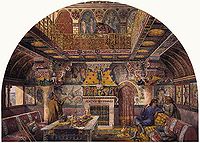
Axel Haig
Encyclopedia

Axel Haig was born on 10 November 1835, on the island of Gotland
Gotland
Gotland is a county, province, municipality and diocese of Sweden; it is Sweden's largest island and the largest island in the Baltic Sea. At 3,140 square kilometers in area, the region makes up less than one percent of Sweden's total land area...
in the Baltic Sea
Baltic Sea
The Baltic Sea is a brackish mediterranean sea located in Northern Europe, from 53°N to 66°N latitude and from 20°E to 26°E longitude. It is bounded by the Scandinavian Peninsula, the mainland of Europe, and the Danish islands. It drains into the Kattegat by way of the Øresund, the Great Belt and...
." His father was a landowner and timber merchant." Haig was apprenticed as a shipbuilder at the government dockyard at Karlskrona and in 1856 went to Glasgow
Glasgow
Glasgow is the largest city in Scotland and third most populous in the United Kingdom. The city is situated on the River Clyde in the country's west central lowlands...
for a further period of training at a firm of Clydeside shipbuilders." But his interests had turned to architecture and in 1859, he undertook a new apprenticeship as a draughtsman in the offices of the Ecclesiastical Commissioners." After seven years there, he launched himself as an architectural artist. The middle years of the nineteenth century saw an explosion in the practice of architectural competitions. The wealth generated by the empire and The Industrial Revolution created the necessary conditions for a vast expansion in civic construction. Commissions for government offices, town halls, churches for private benefactors, railway termini were all put out to tender and competing architects required draughtsmen to illustrate their plans. In 1866 Haig met William Burges
William Burges (architect)
William Burges was an English architect and designer. Amongst the greatest of the Victorian art-architects, Burges sought in his work an escape from 19th century industrialisation and a return to the values, architectural and social, of an imagined mediaeval England...
when Burges retained him to illustrate his designs for the Royal Courts of Justice
Royal Courts of Justice
The Royal Courts of Justice, commonly called the Law Courts, is the building in London which houses the Court of Appeal of England and Wales and the High Court of Justice of England and Wales...
in The Strand. Haig produced a series of watercolour illustrations that were "an immediate sensation." The competition's winner, George Edmund Street
George Edmund Street
George Edmund Street was an English architect, born at Woodford in Essex.- Life :Street was the third son of Thomas Street, solicitor, by his second wife, Mary Anne Millington. George went to school at Mitcham in about 1830, and later to the Camberwell collegiate school, which he left in 1839...
is said to have remarked, "I wouldn't mind being beaten by drawings like those."
Haig and Burges continued in partnership until the latter's death in 1881. In that time they jointly produced some of the most spectacular medieval visions of the Victorian Gothic Revival. Cardiff Castle
Cardiff Castle
Cardiff Castle is a medieval castle and Victorian architecture Gothic revival mansion, transformed from a Norman keep erected over a Roman fort in the Castle Quarter of Cardiff, the capital of Wales. The Castle is a Grade I Listed Building.-The Roman fort:...
, Knightshayes Court
Knightshayes Court
Knightshayes Court is a Victorian country house in Tiverton, Devon, England, designed by William Burges for the Heathcoat-Amory family. Nikolaus Pevsner describes it as "an eloquent expression of High Victorian ideals in a country house of moderate size." The house is Grade I listed as of 12 May...
, the Church of Christ the Consoler
Church of Christ the Consoler
The Church of Christ the Consoler is a Victorian Gothic Revival church built in the Early English style by William Burges. It is located in the grounds of Newby Hall at Skelton-on-Ure, in North Yorkshire, England...
at Skelton-on-Ure
Skelton-on-Ure
Skelton-on-Ure or Skelton is a village and civil parish in the Harrogate district of North Yorkshire, England. It is situated about 1 mile west of Boroughbridge, near the A1 road motorway....
, St Mary's Church, Park House
Park House, Cardiff
Park House, formerly known as McConnochie House, is a town house in Cardiff. It was built for James McConnochie, Chief Engineer to the Bute Docks, by the Gothic revivalist architect William Burges. It is a Grade I listed building...
, the Speech Room, Harrow School, Castell Coch
Castell Coch
Castell Coch is a 19th-century Gothic Revival castle built on the remains of a genuine 13th-century fortification. It is situated on a steep hillside high above the village of Tongwynlais, to the north of Cardiff in Wales, and is a Grade I listed building as of 28 January 1963.Designed by William...
, Trinity College, Hartford, Connecticut
Connecticut
Connecticut is a state in the New England region of the northeastern United States. It is bordered by Rhode Island to the east, Massachusetts to the north, and the state of New York to the west and the south .Connecticut is named for the Connecticut River, the major U.S. river that approximately...
and the designs for the re-decoration of Saint Paul's Cathedral: as Burges designed his most important commissions, so Haig drew them. "In Haig, Burges, the architect of a medieval dreamland, had found an artist worthy of his dreams." "
Haig developed a second career as an etcher and his drawings and lithographs of european castles, palaces, landscapes and cathedrals became hugely popular in late-Victorian England. " In a review of his work published by RIBA
Riba
Riba means one of the senses of "usury" . Riba is forbidden in Islamic economic jurisprudence fiqh and considered as a major sin...
in the year of his death, Maurice Adams wrote that "his architectural draughtsmanship ranks without a doubt amongst the foremost of his time and his graphic capability remains unique."

